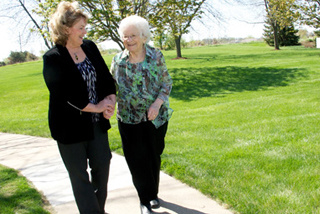Alma Olson has relied on faith, family, and fortitude to help her live a long and fulfilling life. At age 90, she’s a symbol of strength and self-reliance.
So when she started feeling tired on a daily basis in fall 2011—to the point where it took a concerted effort to join group activities at her Iowa City senior living residence—Olson had a simple explanation.

“I figured I just needed to give it a little more ‘oomph,’” she says.
Daughter Karen Arthur and other family members noticed Olson’s constant fatigue.
“Mother was exhausted all the time,” Arthur says. “It got to the place where she didn’t have the energy to go visit Dad (Alma’s husband, Arno, 96, lives at a nearby care center) or even go to church. That’s just not her.”
A couple of years earlier, Olson had been diagnosed with aortic stenosis—a narrowing of the heart’s aortic valve through which oxygen-rich blood from the heart’s main pumping chamber flows into the aorta and out to the rest of the body. A poorly functioning aortic valve means the body doesn’t get enough blood, which causes the heart to work even harder. Left untreated, it can lead to heart failure or cardiac arrest.
Olson’s aortic stenosis was due to calcium deposits that had formed around her aortic valve over time. By last winter, it was clear that her condition had worsened. Olson’s primary care provider referred her to University of Iowa Heart and Vascular Center, which recently had become the first and only heart care program in Iowa to offer a new aortic valve procedure that does not require open-heart surgery.
The new approach, called Transcatheter Aortic Valve Replacement (TAVR), uses a prosthetic valve that is compressed onto a balloon. The valve is inserted into a large artery in the patient’s thigh and advanced to the valve site. The new valve is then carefully positioned and expanded with the balloon, making it immediately functional.
Learn more about TAVR at www.uihealthcare.org/TAVR or call the UI Heart and Vascular Center at 319-384-6245 for more information.
For elderly and high-risk patients with severe stenosis who are eligible for TAVR, the procedure is a breakthrough, notes Phillip Horwitz, M.D., an interventional cardiologist with UI Heart and Vascular Center.
“This allows us to offer a life-saving treatment for a common disease to patients who would have been considered untreatable in the past,” Horwitz says.
Patients like Alma, for example. Given her age and condition, Alma was considered too high risk for invasive surgery. Before TAVR, she most likely would have had to “live with” her stenosis. The majority of patients like Alma who are untreatable die within one year, Horwitz notes.
The fact that TAVR was a new procedure didn’t faze Alma. She let her faith in God and her trust in the UI heart care team guide her.
“Dr. Horwitz told us about it, and I said, ‘Let’s go,’” Olson says. “I wasn’t worried at all. I figured if they have something that will work, fine.”
“The UI team gave us an overwhelming feeling of total confidence,” recalls daughter Arthur. “The caring and expertise shown by Dr. Horwitz, Dr. (Gardar) Sigurdsson, Dr. (Robert Saeid) Farivar, and the nurses were so invaluable. They put us at ease.”
Several days later, Olson returned for her new aortic valve. The procedure went well, and four days later she was able to go home. Remarkably, Olson says she’s had “no pain at all.” She now participates in an outpatient rehab and exercise program through UI Heart and Vascular Center called CHAMPS (Cardiovascular Health, Assessment, Management, and Prevention Service) and is making great progress.
“I feel good,” Alma says. “I would certainly recommend it to others if they are a candidate for this type of surgery.”
“She now has a new lease on life,” marvels Arthur. “They told her she has the body of an 80-year-old and the heart of an 18-year-old. How great is that?”